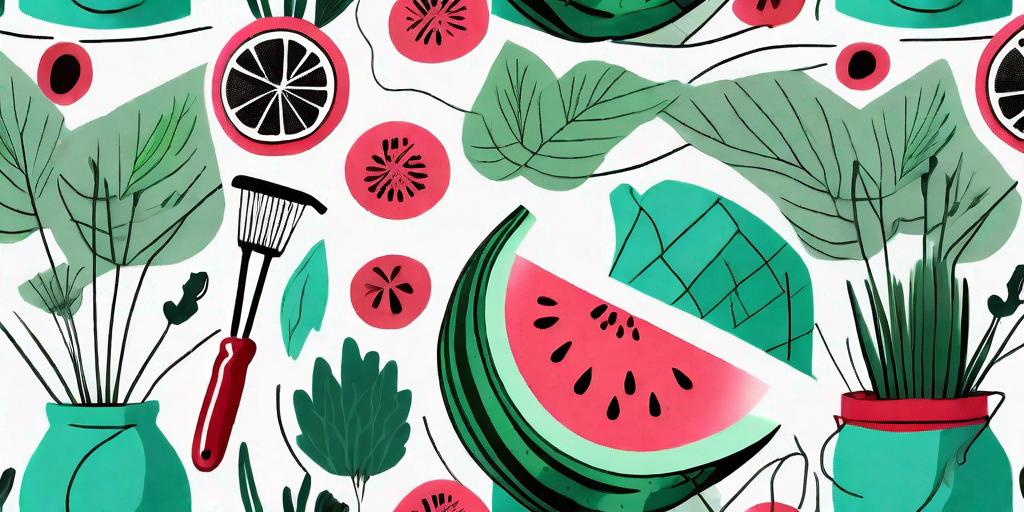
Watermelons, the quintessential summer fruit, are not only refreshing but also a fun challenge for the backyard gardener. If you've ever wondered how to grow the sweetest, juiciest, most crimson watermelon in your own backyard, you're in the right place. Prepare to become the envy of your neighborhood with your watermelon-growing prowess!
The Watermelon Basics
Before we dive into the juicy secrets of growing watermelons, let's cover the basics. Watermelons are warm-season fruits that thrive in temperatures between 70 and 85 degrees Fahrenheit. They require a long growing season (at least 80 days) and plenty of space to sprawl.
Watermelons come in a variety of sizes and colors, but we're focusing on the sweet, crimson variety. These watermelons typically weigh between 20 and 25 pounds when mature, and have a dark green, striped rind.
Choosing the Right Variety
When it comes to growing the sweetest crimson watermelon, variety matters. 'Crimson Sweet' is a popular choice due to its high sugar content and deep red flesh. 'Sugar Baby' is another sweet, red-fleshed variety that's a bit smaller, making it a good choice for smaller gardens.
Other varieties to consider include 'Black Diamond', 'Charleston Gray', and 'Moon and Stars'. Each of these varieties has its own unique flavor profile and growth habits, so choose the one that best suits your taste and garden conditions.
Preparing the Soil
Watermelons prefer well-draining, sandy loam soil with a pH between 6.0 and 6.8. Adding organic matter, such as compost or well-rotted manure, can improve soil fertility and structure. A soil test can provide valuable information about your soil's pH and nutrient levels, helping you make necessary adjustments for optimal watermelon growth.
Remember, watermelons are heavy feeders, so don't skimp on the nutrients. A balanced fertilizer can provide the necessary nitrogen, phosphorus, and potassium for healthy growth and sweet, juicy fruit.
Planting and Care
Now that we've covered the basics, let's get to the fun part: planting and caring for your watermelons. This is where the magic happens, and where you can start to see your sweet, crimson dreams come to fruition (pun intended).
Watermelons can be started from seed indoors, or sown directly in the garden after the danger of frost has passed. They should be planted in hills or mounds, with 2-3 seeds per hill. Once the seedlings have a few true leaves, thin to the strongest plant.
Watering and Fertilizing
Watermelons need consistent watering, especially during dry spells. However, avoid watering the leaves to prevent disease. Instead, water at the base of the plant or use a soaker hose.
As for fertilizing, a balanced fertilizer at planting time is a good start. Once the plants start to bloom, switch to a low-nitrogen, high-potassium fertilizer to encourage fruit development.
Pest and Disease Control
Like any garden plant, watermelons can be susceptible to pests and diseases. Common pests include aphids, cucumber beetles, and vine borers. Diseases to watch out for include powdery mildew, anthracnose, and fusarium wilt.
Good garden hygiene, crop rotation, and choosing resistant varieties can help prevent many of these problems. If pests or diseases do strike, organic or chemical controls may be necessary.
Harvesting and Enjoying Your Watermelon
After all your hard work, it's time to enjoy the fruits of your labor. But how do you know when your watermelon is ripe? There are a few telltale signs to look for.
First, the bottom of the watermelon (where it sits on the ground) should be a creamy yellow color. Second, the tendril nearest the fruit should be brown and dry. Lastly, give it a tap. A ripe watermelon will have a hollow sound.
Storing and Using Your Watermelon
Once harvested, watermelons can be stored at room temperature for about a week, or in the refrigerator for 2-3 weeks. To maximize freshness, don't cut the watermelon until you're ready to eat it.
Watermelon can be enjoyed fresh, in salads, or in drinks. It's also a great addition to BBQs and summer parties. Just be prepared to share, because everyone will want a taste of your sweet, homegrown watermelon!
FAQs
- Can I grow watermelons in containers?
Yes, but choose a smaller variety and a large container. Also, be prepared to water and fertilize more frequently.
- Why are my watermelons small and tasteless?
This could be due to a lack of nutrients, inconsistent watering, or poor pollination. Make sure your plants are well-fed, watered, and visited by bees.
- Can I grow watermelons in a cold climate?
Yes, but choose a short-season variety and start the seeds indoors. You can also use black plastic or row covers to warm the soil and protect the plants.
So there you have it, the juicy secrets to growing the sweetest crimson watermelon in your backyard. Now get out there and start planting. Your taste buds (and your neighbors) will thank you!











